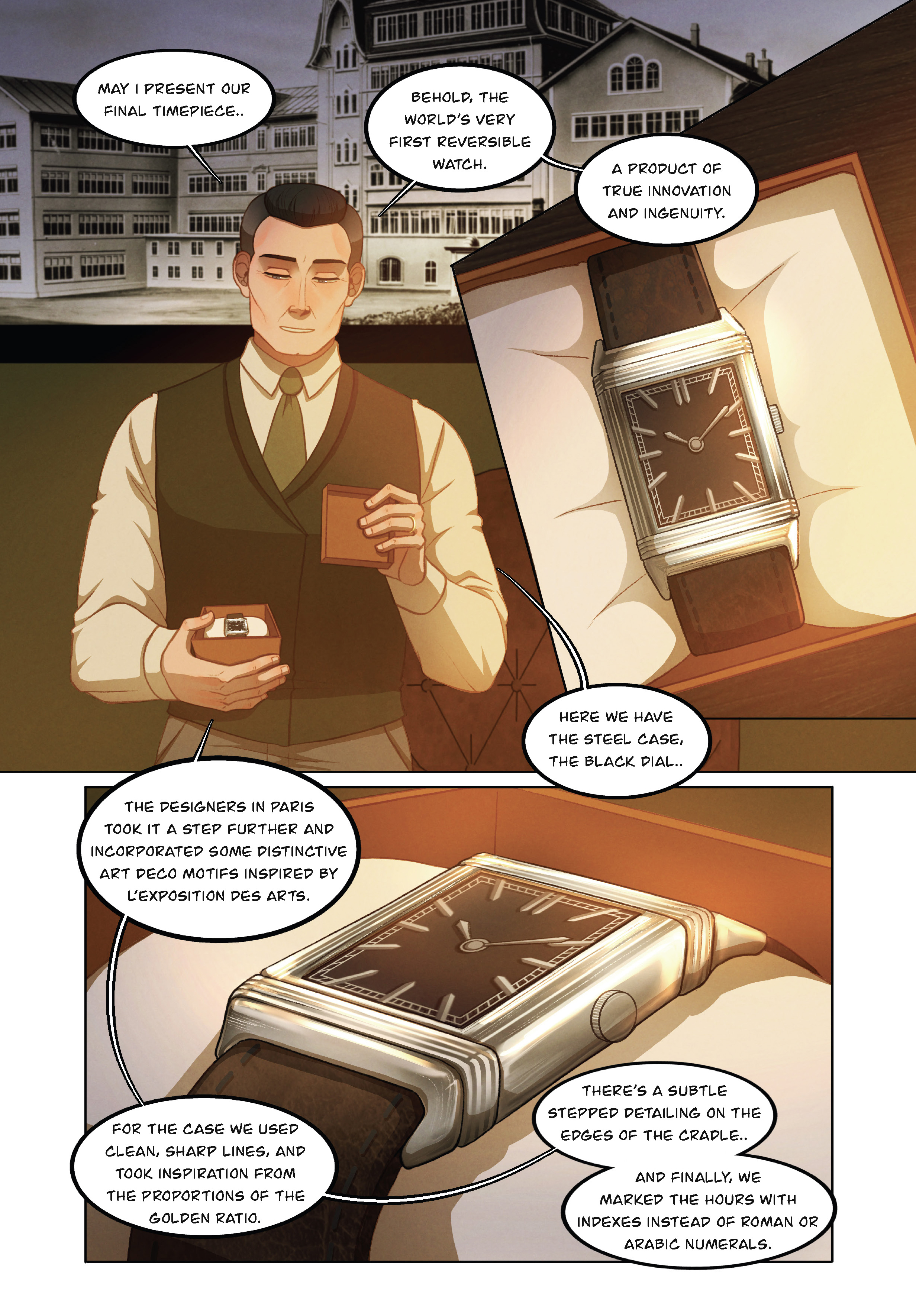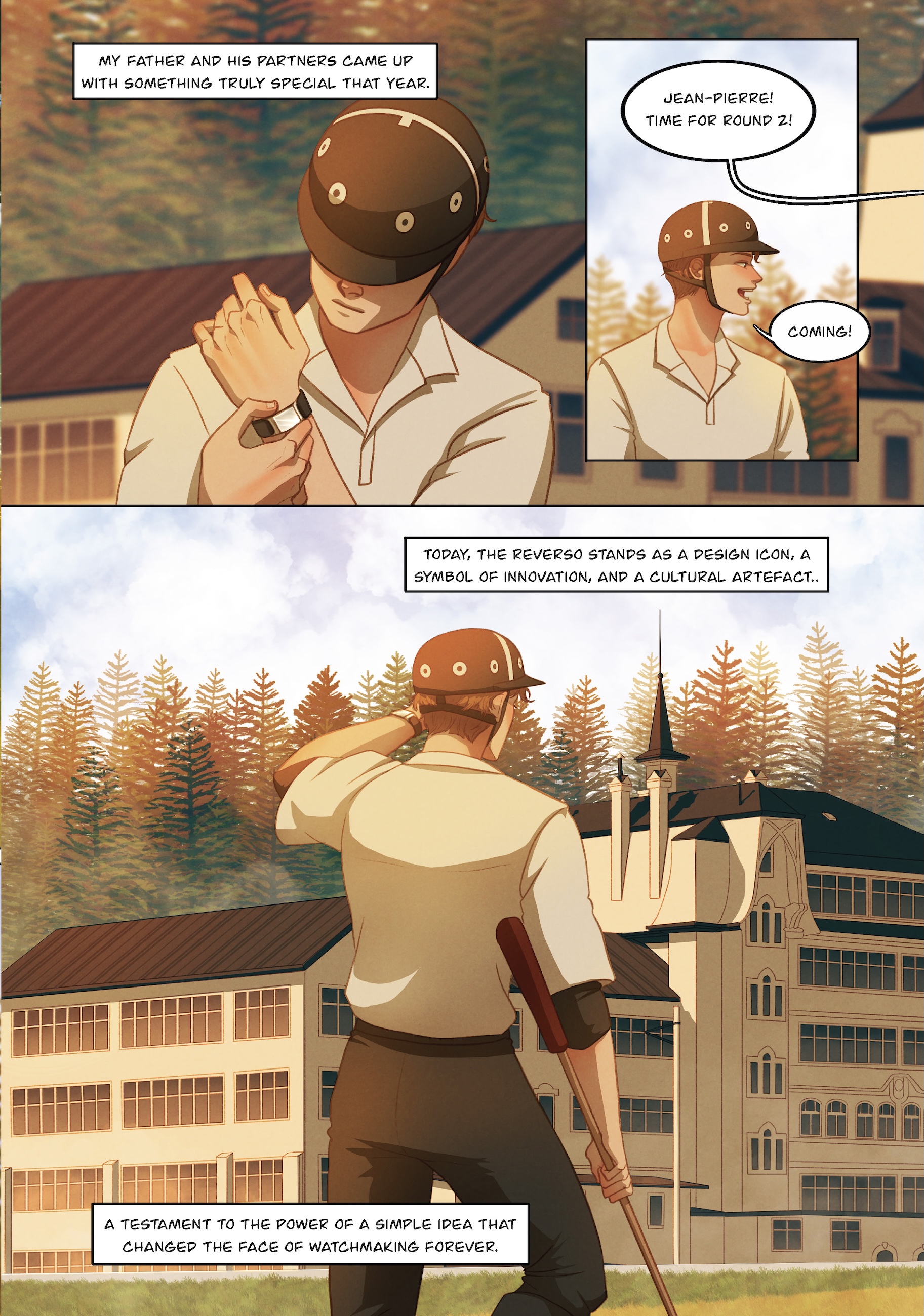F L A U N T


Perhaps no other concept has perplexed, controlled, defeated humankind like the mechanisms of time. Time is an idea, a man-made construct, an enigma unseen. Does it exist in a straight line, or does it fold back upon itself? It wrinkles the skin, withers the flower, sets the score for life, death, rebirth, renewal. Yet, for all of time’s tricks and ambiguities, Swiss watchmaker Jaeger-LeCoultre seems to materialize it in the clearest terms.
Each year, Jaeger-LeCoultre’s Made of Makers Program considers the relationship between horology and the arts in a creative collaboration with an emerging artist. Past installments include a perfumer, a gastronomist, a chocolatier, a street light painter, to mention only few of the many craftspeople, designers, and artisans Le Grand Maison has partnered with from around the globe. This year, Jaeger-LeCoultre teams up with self-taught, Philippines-based Webcomic designer Olivecoat (pen name Lily Catan) to recount the birth of the Reverso watch—whose design and manufacturing transformed the watchmaking world—through a five-chapter comic story.
Maybe it’s not so much the reality of time that concerns us, but the undeniable sensation of it slipping away. If the impermanence of everything might be given a soothing balm, surely it involves those memories made in the intermediate, the advancements we made within the small period of experience we’re offered. For Jaeger-LeCoultre, what is inherently represented by being a watchmaker might be better underscored by the stories forged in the making of the brand. Specifically, it is the history of the Reverso, a timepiece that helped propel Jaeger-LeCoultre into that vaunted class of horological sophistication.

This is a story of elegance and practicality, and it begins nearly 100 years ago in India’s Polo Fields. Polo players needed a timepiece that could withstand the roughness of their sport, which often shattered the glass of their watch face during a match. Olivecoat’s creation, a majority of which is based on true events, tells the story of entrepreneur César de Trey ideating a watch that could be flipped over to withstand the boisterous nature of the sport, while remaining sleek, gentlemanly, and fashionable. As with every great story, this Webcomic is about so much more than just the creation of the Reverso, but is a narrative about the importance of nurturing creative partnerships, valuing team efforts, and confronting challenges. Through her own rigorous profession, Olivecoat portrays the beauty, the feat that is watchmaking: the ultra-thin mechanical movements, the incredible complications, the sourcing together of perfect elements to create a groundbreaking timepiece.
For whatever smartphones and digital modernity have delivered in terms of time-telling convenience, timelessness seems forever on the back burner. What persists for Jaeger-LeCoultre is the story, the lineage, and indeed the artistry behind the Grand Maison. The latest Made of Makers collaboration is a commemoration of the history of the watchmaking arts through an embrace of a contemporary medium–a celebration of time in all its facets.
In a conversation with Olivecoat and Jaeger-LeCoulture CMO Matthieu Le Voyer, we discuss the ideas, significance, and inspirations behind their newest venture together.

Thinking about the Made of MakersTM program, how important is it to you that Jaeger-LeCoultre is seen in the marketplace primarily in terms of delivering artistic value?
Matthieu Le Voyer: Initially, we asked ourselves a fundamental question: Is watchmaking an art, or is it a craft? And if there is a difference, what exactly distinguishes art from craftsmanship? When we discussed this topic, it led to many reflections and debates and there was no clear answer. The only recurring idea that seemed to define craftsmanship, across all disciplines, was functional utility.
Today, people no longer need a watch to tell time, they can simply check their smartphone. A watch is no longer purely functional as there is a certain beauty in reading time on a timepiece. From that realization, we began to consider watches as works of art. That became our starting point for our Made of MakersTM program: to explore the bridges between art and watchmaking, and to see whether watchmaking could also be viewed as a form of art.
Since the beginning, we have developed a dozen collaborations, each rooted in a distinct artistic field, and each one reinventing classical art through a new creative lens.
Whether it is painting, cinema, sculpture, music, gastronomy, or perfumery: all these disciplines share the same spirit of creation.
The second aspect of our reflection tackles the notion of what makes something classic. For many, Jaeger-LeCoultre embodies what is timeless, refined, sophisticated, and elegant and that is exactly how they would define a classic. But to me, being classic as a brand does not mean being conventional. What we see as classic and timeless today does not mean being confined to the past and was even considered disruptive and avant-garde when it first appeared. History, in retrospect, decides what becomes classic. The Maisons that defined their eras were anything but conventional at the time, they were bold. What we aim to do is to bridge watchmaking and the arts, to express that classic can also mean creative. That is what we explore through our collaborations, even bringing the ninth art, the comic art, into dialogue with the fine arts.

When thinking about artists to collaborate with, how much are you thinking about the extent to which you believe their work has parallels in horology?
Matthieu Le Voyer: When curating our Made of Makers™, we want to involve creative minds from outside the world of horology.
We follow three main criteria. First, we look for artists who are truly talented in their own field—recognized for their mastery and craftsmanship—but not necessarily already famous or fully established. We like to shine light on those who deserve to be better known, and all this curation is done in-house.
Second, we often seek artists who did not follow a traditional academic path, those who learned their art through practice, dedication, and experimentation. That philosophy resonates deeply with Jaeger-LeCoultre: at the Manufacture, skills are refined through experience and repetition. This gives the artists an intuitive approach and makes them more likely to transcend what already exists and to create something genuinely new and distinctive.
Finally, our choices reflect our Maison’s DNA, we value understatement, sincerity, authenticity, and hard work. That is how we chose Olivecoat, we found her work ethic and creative personality deeply aligned with our own spirit.
What was it specifically about [Olivecoat’s] style and artistic vision that you thought made her a good match for the Made of MakersTM programme?
Matthieu Le Voyer: Alongside her dedication and talent, we were deeply moved by her tone of voice. When we discovered her work and her webcomics, we felt a strong sense of sincerity as she designs with genuine emotion and focuses deeply on human interaction, which is, in my view, the main ingredient of great storytelling. Her tone is engaging as her stories are told in a light, natural, and authentic way.
As mentioned, she is a self-taught artist who crafts storytelling experiences. She specializes in webcomic design, reinventing narratives by taking timeless emotions and reshaping them into immersive digital worlds.
We also appreciated how her graphic style is influenced by Eastern visual art while telling a story rooted in Western heritage, all through a contemporary lens. It is a dialogue between two worlds, two narrative rhythms converging on the page—a vertical journey into the world of fine watchmaking that reinvents a classic of the 9th art.
More than maybe any other collaboration, a webcomic design seems to fuse the modern, technological age with the decidedly nondigital history of the Reverso. How does the role of JLC change or expand as the world moves more in this direction?
Matthieu Le Voyer: With this collaboration, we wanted to infuse a digital and easily accessible format—a snackable storytelling approach—through a five-chapter webcomic retracing the genesis of the Reverso. In doing so, we have become storytellers: reinventing an icon, acting as the spokesperson for a beautiful legacy, and sharing it in a way that resonates with today’s audience.
As the world becomes increasingly digital, our role expands beyond that of watchmakers. We see ourselves as curators of heritage and interpreters of time—staying aligned with the present while always paying tribute to those who made it possible.
How unique was it for you to partner with Jaeger-LeCoultre in such a way, and was the level of collaboration here a challenge for you artistically?
Olivecoat: I think it has been an entirely unique collaboration, to create this conversation between watchmaking and comics, between a heritage brand and the world of webtoons, and I am very honored to be a part of it. It was certainly a challenge because the Reverso story is such a serious and rich one, while I tend to see myself as a rather lighthearted person.
I wanted to bring a sense of lightness to the story while still respecting the brand and all it stands for and finding that balance was tricky at the start.
What emotional or philosophical layer did you want this collaboration to add to the story of the Reverso?
Olivecoat: I really wanted to focus on humanizing the story of the Reverso, bringing these historical figures to life so that they felt like real people. By showing the world of watchmaking through the eyes of Jean-Pierre, the fictional character I created, I hoped to inspire a deeper appreciation for the craft and its legacy.
Generally, how much are you thinking about temporality in your art?
Olivecoat: With comics, you are constantly thinking about the passage of time. Between scenes, especially when a significant amount of time has passed in the story, I often add voiceover text over a montage of background panels to gently transition the reader from one moment to the next.
I also think a lot about how the scrolling format makes reading a comic feel effortless, so much so that readers do not realize how much they have already read. My main webtoon, Honbarian, has over 150 episodes, and I still receive messages from new readers who tell me they have read the entire series in just two days. In the story, whole months have passed, while for the reader, it has only been two days.
And that is beautiful, is it not? Thinking about how rich a life can feel after experiencing so much time—simply through the act of reading a story.

Were any other ideas floated out there when thinking about the narrative for this project?
Olivecoat: When we began exploring possible narrative directions for the project, one early idea was to introduce a fictional female engineer as part of the team. At that stage, we believed that, beyond the two main characters, the rest of the cast would need to be created from imagination. However, after further discussion, we decided to revisit the historical archives to identify authentic figures who could enrich the story instead.
That research led us to discover Jeanne Pellet, whose presence brought additional depth and authenticity to the narrative. In the end, nearly ninety percent of the story is drawn from true historical events, with only a delicate ten percent imagined weaving the narrative. I believe the story is far more compelling as a result.
The story of the Reverso is one of Asian influence meeting European design. To what extent was that parallel considered both in deciding upon the collaboration and the project itself?
Olivecoat: I think it is always interesting when you bring two wildly different worlds together in this way where East meets West, present meets past, an almost 200-year-old legacy brand meets an indie webcomic creator who has not even been in the industry for five years. The Jaeger-LeCoultre brand has this very serious and dignified air about it, while I, on the other hand, am the polar opposite. I was saying to the team that it might be a Filipino thing, but we are a very unserious people. Sometimes that is good, and sometimes not so. But my stories have always been able to connect with my readers, no matter where they are in the world. I like to portray what we call the human condition—how we all experience it in similar ways, and how we’re all fundamentally very alike. And to do that, you need a measure of vulnerability and openness. This is what I wanted to bring to the collaboration, and it was tricky to find the right balance that would both humanize the Reverso story while still honoring the brand.
Matthieu Le Voyer: From the very beginning, the dialogue between Asian influence and European design was central to our thinking. The Reverso itself has always embodied a meeting of worlds, as its origins in the 1930s were inspired by functional needs in the East, while its design language is unmistakably European.
As mentioned previously, the Made of Makers™ program is itself a reinvention of an art through a contemporary lens—the result of a craft repeatedly perfected with a disruptive vision, an encounter between tradition and modernity, and here, specifically, between East and West, where two creative worlds coexist and nourish each other.
This parallel between two universes was never incidental; it was foundational both to the selection of Olivecoat and to the shaping of the project’s narrative itself.

What does it mean to revisit the genesis of Reverso through a modern creative collaboration?
Olivecoat: I have always loved it when writers and storytellers are able to draw figures from the distant past and find a way to make them relevant today. Stories can leave a mark on your heart in a way that no amount of reading a list of facts ever could. I think that by fleshing out this story that happened so long ago; by inserting emotional elements and making key characters feel real and distinct, we have created something that leaves that mark. Instead of reading only names on a page, we can experience how it happened with them, and that is what creates that emotional connection.
Matthieu Le Voyer: Reverso is our icon. It is timeless. Revisiting its genesis through a modern collaboration means reinterpreting our history not through the traditional lens of heritage, but through the lens of human creativity and connection. We wanted to retell its story like a contemporary tale: accessible, emotional, and engaging, for both connoisseurs who believe they know everything about the Reverso and for a new generation discovering it for the first time. Because some stories do not just mark time; they reshape how we see it and the webcomic format was a discovery for us.
It makes the reading effortless and sincere. It recalls the charm of the early 20th century Sunday comics that appeared in newspapers each week, yet here it is revisited through a digital lens.
We designed it in five chapters, allowing an easily digestible, “snackable” content that can be enjoyed anywhere, anytime. And while digital is the main vehicle, we also created a physical edition for collectors: a beautifully crafted object, almost like a coffee table book in comic form, designed to endure the test of time and live alongside the digital version.
How do you both navigate the space between tradition and innovation?
Olivecoat: With all the new tools and technologies available, it is important for any craft to retain that aspect which ties it to its craftsman. When a person sits down and focuses intently on the work, there is a kind of magic at play. There will always be ways to optimize workflow and tools to make things easier, but at its core, a craftsman must sit down and do the work. The human element must remain. Only a human being can dream, imagine, and innovate. With the rise of technology, it is important to keep in mind that while some processes can be automated, for others—especially in the creative fields—there is simply no replacement for a craftsman at work.
Matthieu Le Voyer: When we speak about watchmaking, the fact that everything is done in-house—from research and development to assembly and decoration—enables our Maison to continuously foster innovation, providing watchmakers with knowledge and expertise they can draw upon when creating new pieces. Jaeger-LeCoultre’s DNA is not only deeply rooted in tradition, but also innovation.
Today, the enduring respect for craftsmanship and the preservation of savoir-faire ensure that a model created more than 90 years ago, such as the Reverso, remains as captivating and relevant as ever. We constantly reinvent ourselves, always with respect for each model’s DNA and original design.
How do you define timelessness in the context of your respective crafts?
Olivecoat: I think stories are timeless. The human condition is timeless. Look at the classics of literature, they still resonate and bear influence today. Are comics timeless? I think so. The cave paintings of old were drawings that told a story. And if some artist from that bygone era had the instinct to tell stories through drawings, the way that I and countless other comic creators do now, I think that instinct will remain far into the future, no matter the medium or tools involved.
Matthieu Le Voyer: Timelessness is beyond the challenges of time, it is about creating pieces that resonate across generations, evoking memories and emotions that remain vivid over time. At Jaeger-LeCoultre, we believe that true timelessness is achieved when innovation respects tradition, and when each creation tells a story that continues to unfold.